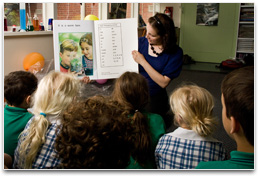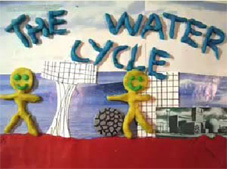This focus idea is explored through:
Contrasting student and scientific views
Student everyday experiences
 Introducing new scientific language to students can cause considerable confusion, particularly when the students may have established a different understanding of the terms from their everyday use. Careful thought needs to be given to the selection of new scientific terms, the choice of language used in definitions and the implications of prior understandings based on everyday use.
Introducing new scientific language to students can cause considerable confusion, particularly when the students may have established a different understanding of the terms from their everyday use. Careful thought needs to be given to the selection of new scientific terms, the choice of language used in definitions and the implications of prior understandings based on everyday use.
As an example, young students are already very familiar with the term ‘gas’ as one used to describe a range of combustible fuels (for example LPG camping gas, BBQ gas bottles or LPG motorcar fuel). The term may also be used to describe the natural gas used in homes for cooking or space heating. The word ‘gas’ in all of these contexts is used to describe a flammable fuel that is burnt to generate heat. It is reasonable to expect this common usage of the word to lead to some confusion when the scientific use of the word is introduced. It is well documented that of the three general states of matter, gases are least well understood by primary students. When most students are asked to give examples of a gas they invariably provide only
uses of gases, i.e. they make strong connections with gas flames and combustion. Students (up to the age of 12) often do not define air as gas because gas is seen as something that is combustible and the air is not.
This confusion occurs with the use of other scientific terms in different contexts as well. For example, the common usage of the word ‘plant’ generally refers to a small, low growing shrub. When the scientific term ‘ Plant Kingdom’ is introduced to students they often have difficulty with the classification encompassing very large trees or small non-vascular mosses. Another example is that the workforce is often used in the context of power relationships, for example, “My parent forced me to make my bed.”
Research: Russell, Longden & McGuigan (1991), Skamp (2004)
Scientific view
When people are engaged in science, the language of communication they use tries to be more precise and consistent. Science often introduces technical words with specific meanings and also gives scientific meaning to words that may have different usage in everyday language.
When considering introducing new scientific words to students, teachers should consider their answers to the following questions:
- Is the word important? –
Is the term in frequent use and of scientific importance to the students? The term ‘orogeny’ has a precise scientific meaning but will its use be helpful to students at their level?
- Does it add to the students’ understanding if it is used? –
Often the meaning of the word is constructed by students through frequent use and by testing its correct application in new contexts.
- Does the student have to know the word now? –
The difference between the terms ‘weight’ and ‘mass’ provide good examples of terms that should be used when they are conceptually appropriate for the student.
- Would insisting on the use of the word be useful to the child? –
The term ‘melting’ describes a change of state which has useful applications in a range of different contexts; it is powerful to students because it can replace a lengthy description with a single word.
Research: Harlen (1993)
Critical teaching ideas
- The difficulties encountered when introducing new scientific language are recurrent across all contexts.
- Introduction and use of appropriate scientific language are important for labelling student experiences.
- The everyday meanings of scientific terms are not wrong but they can cause considerable confusion for students.
- Question the use of scientific terms and when they are conceptually appropriate for students.
 Consider the introduction of scientific language whenever you explore the relationships between ideas in the
Concept Development Maps.
Consider the introduction of scientific language whenever you explore the relationships between ideas in the
Concept Development Maps.
For young children, being able to identify a process, event or group of objects with a precise scientific term is often a very empowering experience. They are frequently keen to identify other areas in their world where this new term can be applied and their understanding of the term can be tested. It is often helpful to use discussion to generate a student need for a new scientific term that provides a label or conveniently describes a process in a shorthand way. This avoids the need for lengthy descriptions and validates the usefulness of the new term.
All students require opportunities to practise the patterns of language that are used to talk and write about scientific knowledge and scientific processes and skills. In science classes, students are frequently asked to ‘estimate’, ‘measure’, ‘observe’ and ‘describe’ events and substances. They may be asked to ‘make predictions’ and ‘draw conclusions’. It should not be assumed that all students have a clear understanding of what these terms require them to do or have established language patterns that allow them to do this effectively.
Pay particular attention to clarifying the meanings of scientific terms where students may already have established everyday understandings which are different to those being taught. For example, a sign reading ‘No animals on the freeway’ implies humans are not animals. Scientific language is often truncated, not intuitive and generally beyond student everyday experiences. When considering the language used, it is important to consider all the language we use, not just the technical terms. The precise way language is used in the classroom by both the teacher and students is important in influencing conceptual change in students.
Research: Parker (1992)
Teaching activities
Practise using and building perceived usefulness of the scientific model or idea
Encourage activities that promote student experience with the language of scientific discourse. Focus on helping students to identify scientific terms that are new to them or terms where their meanings remain unclear. Encourage students to practise language patterns that assist them to describe events, objects, and processes, making predictions and drawing conclusions. Encourage short verbal reporting by students or presentations to their peers where particular scientific terms should be used.
Clarify and consolidate ideas for/by communication to others
Work with students to develop a chart of useful scientific terms. This could be on permanent display in the classroom and students could be encouraged to make additions as new scientific terms arise or are introduced. Have students collect or develop a range of images that assist in understanding the meanings of the terms of the context in which they are used. Students could work on developing their own scientific dictionary for use in a particular context of the study. Scientific definitions could be written in their own words or students could draw or collect visual images to help improve their understandings of the terms encountered.
Assist students to identify how the scientific understanding of the term is different to their everyday understanding of the term. Provide students with a series of cards on which two definitions are offered as distractors and one is scientifically acceptable. Have three students read out each of the definitions for the class to pick which definition is scientifically acceptable. This could run as a panel-like quiz show. As a variation, students could be asked to write down the difference between their everyday understanding and the acceptable scientific use of the term. A good analogy is the usefulness and convenience of SMS text for rapid phone communication. Short combinations of letters are quick to write (such as ‘lol’ or ‘cya’), but still, convey meaning to those who know how to interpret them. This is the same with chemical equations and numerous scientific terms. It is appropriate to use terms in different ways in different contexts.
Clarify and consolidate ideas for/by communication to others
 Adopt teaching approaches that allow students to practise verbal, visual and writing skills. It is important for students to have experiences of ‘doing’ science and also of developing skills to communicate their findings to others.
Adopt teaching approaches that allow students to practise verbal, visual and writing skills. It is important for students to have experiences of ‘doing’ science and also of developing skills to communicate their findings to others.
Reports need not always be formal laboratory reports. Present students with the challenge of writing for different audiences. Investigate:
- writing a script for a children’s television program which explains a scientific process or event
- verbal reporting of findings from small group investigations back to the whole class
- writing a scientifically acceptable adaptation to a movie script or cartoon where the science in the original is clearly wrong
- drawing annotated cartoons that are scientifically acceptable to demonstrate a scientific event or process
- developing ‘slowmation’ digital media clips to explain a scientific process.
Practise using and building perceived usefulness of the scientific model or idea
Encourage the publication of students’ scientific observations and reports in the school newsletter, on the school website or in the local newspaper. For example, students could report on measuring the water quality of a local creek or investigate the spread of invasive weeds in the local area and describe their effect on the habitat of indigenous frogs.
Provide students with experiences of popular scientific reporting via television science shows like
Catalyst or the CSIRO’s
Double Helix magazine or other popular science media.